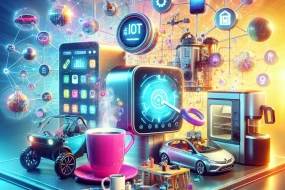
Imagine a city where traffic flows smoothly, energy consumption is optimized, and public services are seamlessly efficient. Welcome to the realm of smart cities—an evolving concept that is transforming urban life as we know it. But what exactly makes a city 'smart'? In this guide, we’ll explore the key technologies driving this revolution, examine their impact on our daily lives, and offer insights into the future of urban living. Whether you're an urban planner, a tech enthusiast, or just curious about the future, this guide offers a comprehensive look at how smart city technologies are reshaping our world.
Understanding Smart City Technologies
Smart city technologies encompass a wide range of innovations designed to improve the quality of urban life. At their core, these technologies leverage data, connectivity, and IoT (Internet of Things) devices to create more efficient and sustainable urban environments. Cities like Barcelona, Singapore, and Amsterdam are leading the way, showcasing how technology can tackle urban challenges such as pollution, traffic congestion, and resource management.
The Role of IoT in Smart Cities
IoT devices are the backbone of smart cities, providing the data needed to optimize urban services. Imagine sensors embedded in traffic lights that adjust in real-time to traffic conditions, or waste bins that signal when they're full. These devices collect and transmit data that city officials can use to make informed decisions. However, the key to success lies in integrating these devices into a cohesive network that communicates effectively with urban infrastructure.
Smart Transportation: The Path to Seamless Mobility
Transportation is often the most visible aspect of a smart city. Innovations like autonomous vehicles, smart traffic management systems, and public transit apps are transforming how we move. For instance, Helsinki's MaaS (Mobility as a Service) app integrates various modes of transportation into a single platform, allowing users to plan and pay for their journeys with ease. But implementing these technologies isn't without challenges—privacy concerns, data security, and infrastructure costs are significant hurdles.
Energy Efficiency and Sustainability
One of the primary goals of smart cities is to reduce their environmental footprint. Smart grids, energy-efficient buildings, and renewable energy sources are crucial components. Cities like Copenhagen are setting ambitious targets for carbon neutrality, using smart meters and building management systems to monitor and reduce energy consumption. However, the transition to smart energy solutions requires significant investment and collaboration between public and private sectors.
Enhancing Public Safety and Security
Smart city technologies also play a crucial role in enhancing public safety. Surveillance systems equipped with AI can detect unusual activities and alert authorities in real-time, while smart street lighting improves visibility and reduces crime rates. In New York City, the Domain Awareness System integrates data from various sources to provide law enforcement with a comprehensive view of the city's security landscape. Yet, balancing security with privacy remains a contentious issue.
Common Challenges and Mistakes
Despite their potential, smart city projects often encounter obstacles. One common mistake is the lack of a clear vision or strategy, leading to fragmented and ineffective solutions. Another pitfall is underestimating the importance of citizen engagement—without public buy-in, even the most advanced technologies can fail. Cities must also be wary of over-reliance on technology, ensuring that human oversight and adaptability remain integral to urban management.
The Future of Smart Cities
As technology continues to evolve, so will the concept of smart cities. Emerging technologies like 5G, AI, and blockchain hold the promise of further enhancing urban life. However, the future of smart cities will depend on our ability to address current challenges, foster collaboration, and maintain a focus on sustainability and inclusivity. The journey towards smarter cities is a marathon, not a sprint, and requires the collective efforts of governments, businesses, and citizens.






























